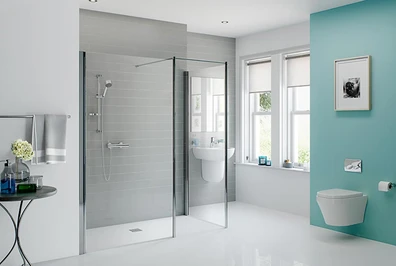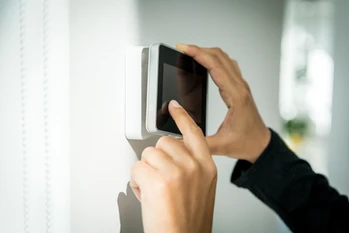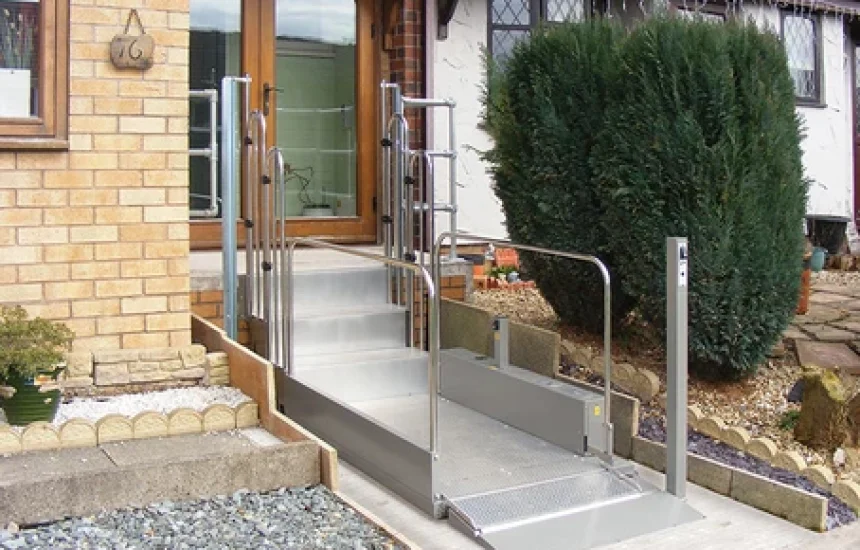The top 5 home adaptations that can help improve the use of your home and make life easier.
Are you looking for practical solutions to adapt your home for an older person or to accommodate someone with restricted mobility?
About 39% of households owned outright include a person with a disability in the UK, according to the latest English Housing Survey. Unfortunately, there is a further 1 in 5 people who need adaptations to their home or believe that their current accommodation is not suitable and accessible for their disability.
In 2015 in South & West Wales there were a reported 113,000 of residents in homes stating they found it difficult to do the usual everyday activities due to a disability.
Having an accessible and safe home ensures that those living with disabilities can be self-reliant, independent and live a full and happy life. So, what home adaptations are available, and how can they improve your day to day life? In this article, we will discuss the top 5 disability home improvements that can make a difference in your life.
1. Installing Grab Rails & Grab Bars

Grab rails and handrails are simple pole structures fixed in places around the home to provide support and stability. The simple grab rail is a very low-cost option to help individuals regain the freedom to navigate their home.
Grab rails can be fitted to help the user as they try to balance themselves when getting up from or sitting down in a chair, walking through long corridors, climbing the stairs, using bathroom facilities or when navigating outside steps leading to and from their home and garden.
A grab rail is most useful in wet or slippery areas, such as bathrooms and the outside, where people are at most risk from a fall. Grab Rails come in several types, and each one has a different function, structure and installation process. Rails and bars must only be fitted to solid stable structures – such a brick/block walls or partition walls with special fixing supports and should never be fitted directly to plasterboard.
Adaptations shouldn’t mean you have to compromise on the aesthetics of your home, grab rails and bard are available in various finishes such as stainless steel, chrome, wood, and plastic – with a range of textures and colours to suit any home décor.
Types of Grab Rails:
Straight Grab Bar – It’s a simple horizontal bar that can be installed to a bathroom wall either horizontally or vertically.
Wave-Style Grab Bar – Similar to a straight grab bar but with a wave design that adds aesthetics to the pole.
Grab Bar Accent Ring – This partial circle grab bar is usually placed around shower knobs and taps. It’s designed to support the user while adjusting or tuning the knob on and off.
Wall to Floor Grab Bars – This is a 90° grab bar commonly fitted near the WC’s or entrances.
Corner Grab Bars – This is another 90° bar designed to be fitted on corners to help with safe and independent movement around the bathroom.
Suction Cup Grab Bar – This is a portable grab bar with a switch that locks it into the wall using a suction cup.
Flip-up and Flip-down Grab Bar – As its name implies, this grab bar commonly installed near commodes can be flipped up or down.
2. Using Smart Home Devices – The Game-Changing Technologies You Can Utilise

Using smart home technologies is a simple and convenient adaptation for your home. Although these devices can be sometimes expensive, investing in these tools can provide a higher level of comfort and independence in your home.
Here are some assistive technologies that can make a disabled person’s life easy:
Leak Sensor
This sensor designed to monitor for leaks at home detects if there are any taps left running and shut them off automatically. This is also a great technology for those diagnosed with arthritis and struggle to use their hands.
Voice Assistants
Smart voice assistants like Amazon Echo and Google are convenient and useful in managing devices at home and making calls in an instant. This is a great tool to have if you are ever in an accident or emergency situations, as you can call your emergency contact just by calling out to your voice assistant. No phone needed!
Smart Thermostat
This smart device helps to maintain the temperature you want in your home and allows you to lower the heat through your smartphone to save energy before leaving your home. You can also switch it back as you arrive at your house. This is very beneficial, especially for a person with cerebral palsy who prefers warm temperature.
Video Doorbell
A doorbell with a motion-sensing camera will let you know who is at the door and inform a person if someone is calling. There are also two-way communication systems that will allow you to talk with a caller and record a face or interaction.
Smart Garage Door Opener
This device will enable you to open your garage wherever you are. It comes in a range of brands, style and with some add-on features.
Smart Curtains, Shades or Blinds
People with restricted mobility may find it challenging to open curtains and blinds, but this smart covering can help. It will allow you to open and close your curtain through an app.
3. Installing Stairlifts – An Automated Stairlift

Another way to improve your home is to install a stairlift. Also known as a chairlift or stair glider, this mechanical device is beneficial for people with restricted mobility who can’t navigate the stairs safely without assistance.
Types of Stairlifts:
Straight Stairlifts
A straight stairlift is a standard automated stairlift designed to lift a person in a straight path without bends or curved angles. It’s the easiest to install and the most affordable of the three options.
Curved Stairlifts
This type of stairlift is suitable for staircases with more than one level or landing, it has a curve designed to match the trajectory of the stairs itself and is able to stop off at different floors of your home or property.
Outdoor Stairlifts
If you need a stairlift for your external stairs that lead to your property’s front door, then an outdoor stairlift is the best option. It is weather and dust resistant, making it hassle-free and convenient.
How can a stairlift benefit you? These are some of the pros of using this motorised chair:
Prevents injuries – It reduces the risk of injuries as it provides a safer way to get from floor to floor.
Smooth and comfortable ride – It also offers a comfortable ride with it’s built-in cushion and arm rest.
Restores Sense of independence – It will help a disabled person regain independence since it will enable them to get up and down the stairs without assistance.
Easy to operate – This motorised device is easy to use. Simply by sitting on the seat, putting on the seatbelt and pressing and holding the rocker switch, it swiftly takes you up and down stairs and will stop moving as soon as you release the button. It also comes with a two-key remote control that will command the stairlift to go, either up or down at your command.
Cost-effective solution – This is also the quickest, most affordable and cost-effective option when compared to the monthly cost of living assistance or single-level homes.
4. Walk in Showers & Walk in Baths- The Safer Solutions For Risky Wet Rooms

A walk-in shower free of doors and curtains provides a range of options and benefits to an elderly or disabled person. You can convert your existing bathroom and personalise and customise it according to your specific needs.
You can also upgrade your walk-in shower by adding some features like a walk-in bathtub. This is a perfect way to upgrade your bathroom and make it more accessible to your needs. A walk-in bathtub has watertight doors that will allow the user to get into the tub over a low threshold, and the tub will be filled with water after closing the door. After bathing, the person can drain the bath and step out of it safely.
Here are some of the advantages of using a walk-in tub:
- It has a low-step height for a quicker and safer entry
- It provides anti-slip flooring that prevents slipping and falling
- It often comes with built-in handrails to provide support while standing and getting out of the tub
- It offers deeper water depth than standard bathtubs
5. Upgrading Security – The Keyless Entry That Unlocks With One Click Away

A smart or automatic lock system is one of the best innovations that could be incorporated in a senior or disabled persons home. With this option, you’ll never worry about leaving the key and the vulnerabilities associated with it. It helps to prevent intruders from entering your home because burglars cannot pick it, unlike conventional door locks.
A smart lock is a safer alternative to a keypad lock because you can control it through a smartphone wherever you are. You can also allow other people like housekeepers, nurses or family members to gain access as a guest, or admin for a limited time through scheduled locking. So, you can control the time and date they can access your home and monitor it via an app that keeps a log. It is even more beneficial for an elderly and disabled person because they will never have a hard time reaching the lock and opening it with a key. With a smartphone or remote, they can already access it with just a single click.
These tips may come with added expenses however, there’s no doubt that it can significantly improve the quality of life of a person with limited mobility and other health issues like visual impairment.

